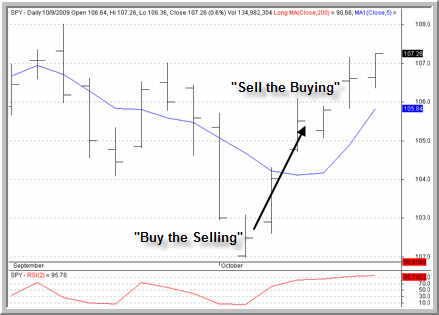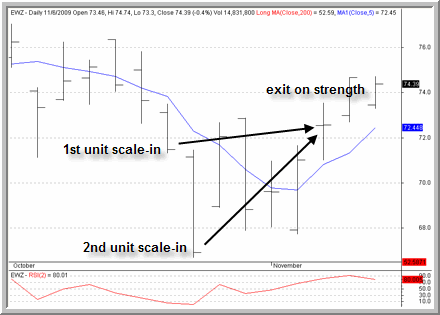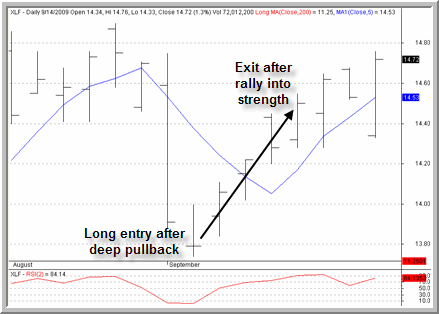New Year’s 2010 Swing Trading College VIII: New Research, New Strategies
When the panic over the potential default of Dubai hit the wires and stocks plunged, were you thinking that it was a good time to sell – or a good time to buy?
For swing traders, panics like the one over the Thanksgiving holiday often represent opportunity. But learning how to take advantage of these kinds of opportunities can be a challenge. Fortunately, this is where resources like the New Year’s 2010 Swing Trading College VIII – with classes starting on Monday, January 4, 2010 – can be vital. If you are new to swing trading – or even if you are a veteran swing trader who wants access to some of the latest quantified research both stocks and exchange-traded funds (ETFs) – the New Year 2010 Swing Trading College may be an opportunity you can’t afford to miss.
Last Chance to the New Year’s Swing Trading College VIII. Click here to learn more NOW.
What is Swing Trading?
Swing trading is a short term strategy for buying and selling highly liquid assets like stocks and exchange-traded funds. Neither day-trading nor trend trading, swing trading operates in a short term, “sweet spot” of 5 to 7 days where traders have been able to discover and quantify edges that make it possible to successfully and profitably trade stocks and ETFs.

Figure 1. S&P 500 SPDRS ETF: This early October pullback in the ^SPY^ was a classic swing trading strategy of what Larry Connors calls “buying the selling and selling the buying.”
These edges, however, are not necessarily what many traders believe them to be. Our research into short term market movement – research first published by Larry Connors in How Markets Really Work and further developed in Short Term Trading Strategies That Work and High Probability ETF Trading – shows that in the short term, buying markets after they have pulled back is a better short term, swing trading strategy than buying markets after they have reached new highs.
Find that hard to believe? In an era in which most trading is some form of “buy high, sell higher” momentum trading, it seems commonsensical that new highs would outperform new lows. But the data suggests otherwise.

Figure 2. iShares MSCI Brazil Index ETF: Scaling-in is powerful way for swing traders to make the most out of swing trading strategies, as this two-part scale-in example of the ^EWZ^ shows.
Traders who enroll in the New Year’s 2010 Swing Trading College VIII led by TradingMarkets CEO and founder Larry Connors will know this research by heart by the time they have completed the 14-week course. But for now, consider this: the average, 5-day gain for all stocks from 1995 through 2006 is 0.31%. If we look at the average, 5-day gain of all stocks that have made 5-day highs, the gain decreases to 0.24%.
If we look at the average, 5-day gain of all stocks that have made 5-day lows, the gain increases to 0.45% – nearly twice that of the 5-day low.
The results are comparable – and comparably quantified – for exchange-traded funds in the short term, as well. Short term lows outperform short term highs.
Is Swing Trading for Me?
What does this mean for the short term swing trader? As students in the New Year’s 2010 Swing Trading College VIII will learn, this key understanding of how markets really work opens up a treasure trove of swing trading strategies that can be used to trade not just stocks, but exchange-traded funds, options, and e-mini equity index futures, as well.
This gives traders a great deal of flexibility when it comes to swing trading strategies that suit their personality and trading style. Relying on the same fundamental understanding of how markets really work, traders can swing trade more or less frequently, more or less aggressively, as well as taking advantage of a variety of asset types and trading strategies from trading ETFs to building high probability, income-producing options spreads.

Figure 3. Financial Select Sector SPDR ETF: Big pullbacks often represent big opportunity for swing traders who are patient enough to wait for them and disciplined enough to trade them. Consider thsi deep pullback in the ^XLF^ from earlier this fall.
Smart traders – like professionals in any field – are always learning and much of the research in the upcoming New Year 2010 Swing Trading College VIII has never been presented before: high probability scale-in strategies for stocks, as well as a new swing trading strategy that has been profitable every year since 1995.
Why not resolve to make 2010 your best trading year ever? Click here to learn more about what the New Year’s Swing Trading College VIII can do for you.
